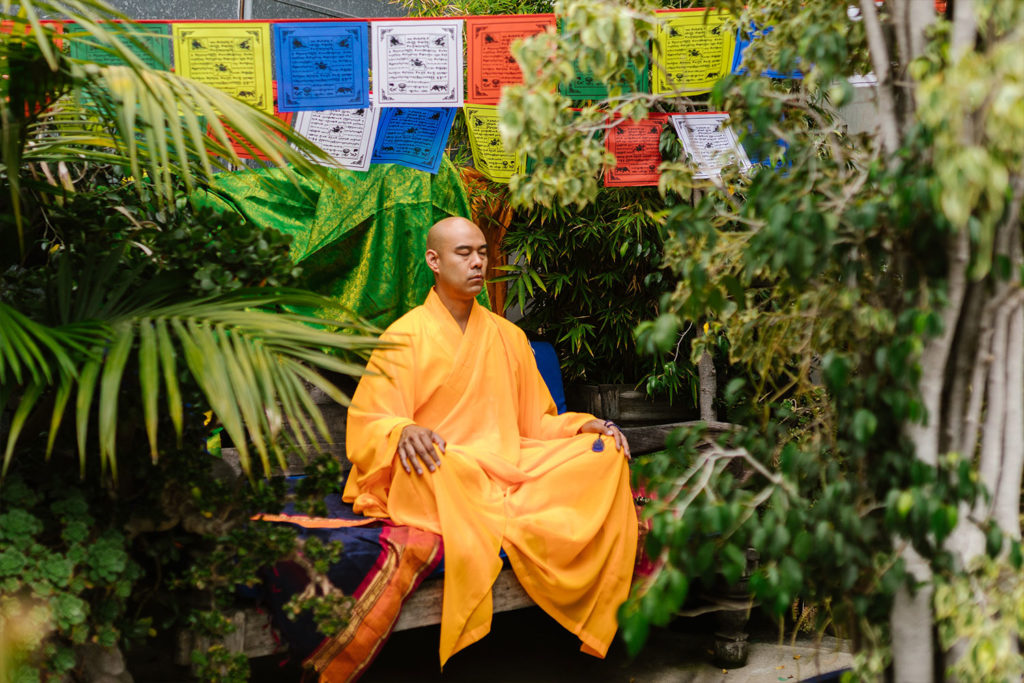Founder: Siddhartha Gautama, a prince from northern India near modern Nepal who lived about 563-483 BC (The name is sometimes written Siddhattha Gotama.)
Scriptures: Various, but the oldest and most authoritative are compiled in the Pali Canon.
Adherents: About 400 million worldwide; approximately 2.5 million in the United States. (Source: Operation World)
General Description:
Buddhism is the belief system of those who follow the Buddha, the Enlightened One; a title given to its founder. Saving oneself comes by following a regimen (path or ritual) and by meditation and reciting mantas. There is no personal relationship with the Buddha or any of the bodhisattvas (saviors who have foregone nirvana to stay back and help others to achieve it). Worship is expressed as adoration of the Buddha and one’s ancestors. Buddhists struggle to make sense of this life and to live out one’s expected dharma (required conduct) as the painful and slow road to moksha (salvation) when all desire is eliminated and one achieves final and ultimate enlightenment.
Buddhism around the World
Today, Southeast Asia and portions of East Asia are predominantly Buddhist. The religion has evolved into three main schools:
- Theravada or the Doctrine of the Elders (38%) is followed in Sri Lanka (Ceylon), Myanmar (Burma), Thailand, Cambodia (Kampuchea), and Vietnam. Theravada is closest to the original doctrines. It does not treat the Buddha as deity and regards the faith as a worldview-not a type of worship.
- Mahayana or the Greater Vehicle (56%) is strong in China, Korea, and Japan. Mahayana has accommodated many different beliefs and worships the Buddha as a god. In Japan, one variation balances militant or aggressive Buddhism by seeking tranquility and peace in the struggles of life.
- Vajrayana or Diamond Vehicle also called Tantric Buddhism or Lamaism (6%) is rooted in Tibet, Nepal, and Mongolia. Vajrayana has added elements of shamanism and the occult and includes taboo breaking (intentional immorality) as a means of spiritual enlightenment.
Growth in the United States
Buddhists regard the United States as a prime mission field, and the number of Buddhists in this country is growing rapidly due to surges in Asian immigration, endorsement by celebrities such as Richard Gere and Tina Turner, and positive exposure in major movies such as Seven Years in Tibet (1997), Kundun (1997), The Little Buddha (1994), What’s Love Got to Do with It? (1993), and Siddhartha (1972). Along with other eastern religions, Buddhism is influencing the New Age movement. Certainly Buddhist growth is benefiting from the rapid growth of New Age thought on American life.
Historic Background
Buddhism was founded as a form of atheism that rejected more ancient beliefs in a permanent, personal, creator God (Ishvara) who controlled the eternal destiny of human souls. Siddhartha Gautama rejected these more ancient theistic beliefs because of difficulty he had over reconciling the reality of suffering, judgment, and evil with the existence of a good and holy God. Gautama taught his philosophy to all social classes of India for 45 years before dying at the age of 80 years old. Buddhism was soon adopted by most of the people in India, achieving the zenith of popularity during the reign of Emperor Asoka from 273 BC until 232 BC. During his life time, Asoka sent Buddhist missionaries to preach Buddhism in South India, Ceylon (Sri Lanka), Syria, Egypt, and Suvarnabhumi (Thailand). In the 10th century AD, Islamic armies swept across India. Since they could not tolerate Buddhism as a rival faith, they persecuted Buddhists to abandon their religion. Buddhism was soon eliminated from the country where it began.
Core Beliefs
Buddhism is an impersonal religion of self-perfection, the end of which is death (extinction)-not life. The essential elements of the Buddhist belief system are summarized in the Four Noble Truths, the Noble Eightfold Path, and several additional key doctrines. The Four Noble Truths affirm that (1) life is full of suffering (dukkha); (2) suffering is caused by craving (samudaya); (3) suffering will cease only when craving ceases (nirodha); and (4) this can be achieved by following the Noble Eightfold Path. The Noble Eightfold Path consists of right views, right aspiration, right speech, right conduct, right livelihood, right effort, right mindfulness, and right contemplation. Other key doctrines include belief that nothing in life is permanent (anicca), that individual selves do not truly exist (anatta), that all is determined by an impersonal law of moral causation (karma), that reincarnation is an endless cycle of continuous suffering, and that the goal of life is to break out of this cycle by finally extinguishing the flame of life and entering a permanent state of pure nonexistence (nirvana).
Bridges for Evangelizing Buddhists
The gospel can be appealing to Buddhists if witnessing focuses on areas of personal need where the Buddhist belief system is weak. One of the difficulties of learning about Buddhism is that if you ask a person about Buddhism, he or she will describe rituals and may not focus on the Buddhist belief system. Some major areas of Buddhist belief include:
Suffering: Buddhists are deeply concerned with overcoming suffering but must deny that suffering is real. Christ faced the reality of suffering and overcame it by solving the problem of sin, which is the real source of suffering. Now, those who trust in Christ can rise above suffering in this life because they have hope of a future life free of suffering. “We fix our eyes not on what is seen [suffering], but on what is unseen [eternal life free of suffering]. For what is seen [suffering] is temporary, but what is unseen [future good life with Christ] is eternal” (2 Cor. 4:18, NIV).
Meaningful Self: Buddhists must work to convince themselves they have no personal significance, even though they live daily as though they do. Jesus taught that each person has real significance. Each person is made in God’s image with an immortal soul and an eternal destiny. Jesus demonstrated the value of people by loving us so much that He sacrificed His life in order to offer eternal future good life to anyone who trusts Him. “God demonstrates his own love for us in this: While we were still sinners, Christ died for us” (Rom. 5:8, NIV).
Future Hope: The hope of nirvana is no hope at all-only death and extinction. The hope of those who put their trust in Christ is eternal good life in a “new heaven and new earth” in which God “will wipe every tear from their eyes. There will be no more death or mourning or crying or pain, for the old order of things [suffering] has passed [will pass] away” (Rev. 21:4, NIV).
Moral Law: Because karma, the Buddhist law of moral cause and effect, is completely rigid and impersonal, life for a Buddhist is very oppressive. Under karma, there can be no appeal, no mercy, and no escape except through unceasing effort at self-perfection. Christians understand that the moral force governing the universe is a personal God who listens to those who pray, who has mercy on those who repent, and who with love personally controls for good the lives of those who follow Christ. “In all things God works for the good of those who love him” (Rom. 8:28, NIV).
Merit: Buddhists constantly struggle to earn merit by doing good deeds, hoping to collect enough to break free from the life of suffering. They also believe saints can transfer surplus merit to the undeserving. Jesus taught no one can ever collect enough merit on his own to earn everlasting freedom from suffering. Instead, Jesus Christ, who has unlimited merit (righteousness) by virtue of His sinless life, meritorious death, and resurrection, now offers His unlimited merit as a free gift to anyone who will become His disciple. “For it is by grace you have been saved, through faith-and this not from yourselves, it is the gift of God-not by works, so that no one can boast” (Eph. 2:8-9, NIV).
Desire: Buddhists live a contradiction-they seek to overcome suffering by rooting out desire, but at the same time they cultivate desire for self-control, meritorious life, and nirvana. Christians are consistent-we seek to reject evil desires and cultivate good desires according to the standard of Christ. “Flee the evil desires of youth, and pursue righteousness, faith, love and peace, along with those who call on the Lord out of a pure heart” (2 Tim. 2:22, NIV).
Jesus and the Eightfold Path
Because Buddhists think a good life consists of following the Eightfold Path, the stages of the path can be used to introduce them to Christ as follows:
Right Views: Jesus is the way, the truth, and the life (John 14:6), and there is salvation in no one else (Acts 4:12).
Right Aspiration: Fights and quarrels come from selfish desires and wrong motives (Jas. 4:1-3); right desires and motives honor God (1 Cor. 10:31).
Right Speech: A day of judgment is coming when God will hold men accountable for every careless word they have spoken (Matt. 12:36).
Right Conduct: The one who loves Jesus must obey Him (John 14:21), and those who live by God’s wisdom will produce good acts/fruit (Jas. 3:17).
Right Livelihood: God will care for those who put Him first (Matt. 6:31,33), and all work must be done for God’s approval (2 Tim. 2:15).
Right Effort: Like runners in a race, followers of Christ must throw off every hindrance in order to give Him their best efforts (Heb. 12:1-2).
Right Mindfulness: The sinful mind cannot submit to God’s law (Rom. 8:7), and disciples of Christ must orient their minds as He did (Phil. 2:5).
Right Contemplation: The secret of true success, inner peace, self-control, and lasting salvation is submission to Jesus Christ as Savior and Lord and setting your heart and mind on things above where He now sits in glory waiting to bring the present order of sin and suffering to an end (Col. 3:1-4).
When Witnessing to Buddhists
- Remember that Buddhists have several special interests:
• attempting to live according to the principles of the Eightfold Path
• escaping from the suffering of endless life
• finding peace through meditation (common in American Buddhism) - Avoid terms such as “new birth,” “rebirth,” “regeneration,” or “born again.” Use alternatives such as “endless freedom from suffering, guilt, and sin,” “new power for living a holy life,” “promise of eternal good life without suffering,” or “gift of unlimited merit.”
- Emphasize the uniqueness of Christ.
- Focus on the gospel message and do not get distracted by details of Buddhist doctrine.
- Understand Buddhist beliefs enough to discern weaknesses that can be used to make the gospel appealing (see “Bridges for Evangelizing Buddhists” and “Jesus and the Eightfold Path”).
- While using bridge concepts, be careful not to reduce Christian truth to a form of Buddhism. Buddhism has been good at accommodating other religions. Do not say “Buddhism is good, but Christianity is easier.”
- Share your own testimony, especially your freedom from guilt, assurance of heaven (no more pain), and personal relationship with Christ.
- Prepare with prayer. Do not witness in your own strength.
For further reading:
Into the Buddhist Mind by Gary & Evelyn Harthcock online at https://chronologicalbiblestorying.com
Original article written by Daniel R. Heimbach, Professor of Christian Ethics, Southeastern Baptist Theological Seminary, Wake Forest, N.C.
Revised 2001 by N.S.R.K. Ravi, of the North American Mission Board, SBC.
Revised and Expanded 2005 by Mark Snowden, of the North American Mission Board, SBC.
Appreciation is expressed to J. O. Terry, Jr., for his insights.
Published March 30, 2016




